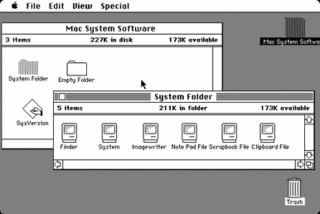
Microsoft Word is a word processing software developed by Microsoft. It was first released on October 25, 1983, under the name Multi-Tool Word for Xenix systems. Subsequent versions were later written for several other platforms including: IBM PCs running DOS (1983), Apple Macintosh running the Classic Mac OS (1985), AT&T UNIX PC (1985), Atari ST (1988), OS/2 (1989), Microsoft Windows (1989), SCO Unix (1990) and macOS (2001).

Microsoft Office, or simply Office, is a family of client software, server software, and services developed by Microsoft. It was first announced by Bill Gates on August 1, 1988, at COMDEX in Las Vegas. Initially a marketing term for an office suite, the first version of Office contained Microsoft Word, Microsoft Excel, and Microsoft PowerPoint. Over the years, Office applications have grown substantially closer with shared features such as a common spell checker, Object Linking and Embedding data integration and Visual Basic for Applications scripting language. Microsoft also positions Office as a development platform for line-of-business software under the Office Business Applications brand. In 2012, Softpedia reported that Office was being used by over a billion people worldwide.

ActiveX is a deprecated software framework created by Microsoft that adapts its earlier Component Object Model (COM) and Object Linking and Embedding (OLE) technologies for content downloaded from a network, particularly from the World Wide Web. Microsoft introduced ActiveX in 1996. In principle, ActiveX is not dependent on Microsoft Windows operating systems, but in practice, most ActiveX controls only run on Windows. Most also require the client to be running on an x86-based computer because ActiveX controls contain compiled code.

Microsoft FrontPage is a discontinued WYSIWYG HTML editor and website administration tool from Microsoft for the Microsoft Windows line of operating systems. It was branded as part of the Microsoft Office suite from 1997 to 2003. Microsoft FrontPage has since been replaced by Microsoft Expression Web and SharePoint Designer, which were first released in December 2006 alongside Microsoft Office 2007, but these two products were also discontinued in favor of a web-based version of SharePoint Designer, as those three HTML editors were desktop applications.
Claris International Inc., formerly FileMaker Inc., is a computer software development company formed as a subsidiary company of Apple Computer in 1987. It was given the source code and copyrights to several programs that were owned by Apple, notably MacWrite and MacPaint, in order to separate Apple's application software activities from its hardware and operating systems activities.

Video for Windows (VfW) is a multimedia framework developed by Microsoft that allows Windows to play and encode digital video.

Internet Explorer for Mac OS X is a proprietary web browser developed by Microsoft for the Macintosh platform to browse web pages. Initial versions were developed from the same code base as Internet Explorer for Windows. Later versions diverged, particularly with the release of version 5, which included the cutting-edge, fault-tolerant and highly standards-compliant Tasman layout engine.

Microsoft Internet Explorer 4 (IE4) is a graphical web browser that Microsoft unveiled in Spring of 1997, and released in September 1997, primarily for Microsoft Windows, but also with versions available for the classic Mac OS, Solaris, and HP-UX and marketed as "The Web the Way You Want It".

Microsoft Internet Explorer 2 (IE2) is the second, and by now discontinued, version of Internet Explorer (IE), a graphical web browser by Microsoft. It was unveiled in October 1995, and was released on November 22, 1995, for Windows 95 and Windows NT, and on April 23, 1996, for Apple Macintosh and Windows 3.1.
Statistica is an advanced analytics software package originally developed by StatSoft and currently maintained by TIBCO Software Inc. Statistica provides data analysis, data management, statistics, data mining, machine learning, text analytics and data visualization procedures.

Microsoft Office 97 is the fifth major release for Windows of Microsoft Office, released by Microsoft on November 19, 1996. It succeeded Microsoft Office 95 and was replaced by Microsoft Office 2000 in 1999. A Mac OS equivalent, Microsoft Office 98 Macintosh Edition, was released on January 6, 1998.
WinFax was a Microsoft Windows-based software product designed to let computers equipped with fax-modems communicate directly to stand-alone fax machines, or other similarly equipped computers.
Links is the name of a series of golf simulation computer games, first developed by Access Software, and then later by Microsoft after it acquired Access Software in 1999. Microsoft also produced its own series of golf games based on Links, under the title Microsoft Golf. The Links series was a flagship brand for Access, and was continued from 1990 to 2003. The first game in the series, Links: The Challenge of Golf, won Computer Gaming World's 1991 Action Game of the Year award.

The family of Macintosh operating systems developed by Apple Inc. includes the graphical user interface-based operating systems it has designed for use with its Macintosh series of personal computers since 1984, as well as the related system software it once created for compatible third-party systems.

The first version of Microsoft Word was developed by Charles Simonyi and Richard Brodie, former Xerox programmers hired by Bill Gates and Paul Allen in 1981. Both programmers worked on Xerox Bravo, the first WYSIWYG word processor. The first Word version, Word 1.0, was released in October 1983 for Xenix and MS-DOS; it was followed by four very similar versions that were not very successful. The first Windows version was released in 1989, with a slightly improved interface. When Windows 3.0 was released in 1990, Word became a huge commercial success. Word for Windows 1.0 was followed by Word 2.0 in 1991 and Word 6.0 in 1993. Then it was renamed to Word 95 and Word 97, Word 2000 and Word for Office XP. With the release of Word 2003, the numbering was again year-based. Since then, Windows versions include Word 2007, Word 2010, Word 2013, Word 2016, and most recently, Word for Office 365.

Links 386 Pro is a golf simulation sports game for MS-DOS released in 1992. It is part of the Links series, and was developed by Access Software as the follow-up to Links: The Challenge of Golf (1990). A Macintosh version, Links Pro, was released in 1994. An enhanced version called Links 386 CD was released for PC in 1995 that included audio comments by comedian Bobcat Goldthwait acting as the player's caddie, and an aerial flyby of each hole streamed from the game's CD-ROM. Re-branded versions of the game were also released for Microsoft Windows under the titles Microsoft Golf 2.0 (1994) and Microsoft Golf 3.0 (1996), part of the Microsoft Golf series.

Michael James Halvorson is an American technology writer and historian. He was employed at Microsoft Corporation from 1985 to 1993 and contributed to the growth of the Microsoft Office and Microsoft Visual Basic software platforms. He is the author of 40 books related to computer programming, using PC software, and the histories of Europe and the United States.

Adobe Premiere was a former video editing software developed by Adobe Systems. It was first launched in 1991, and its final version was released in 2002. It was replaced by Adobe Premiere Pro, a rewritten version of Adobe Premiere.












